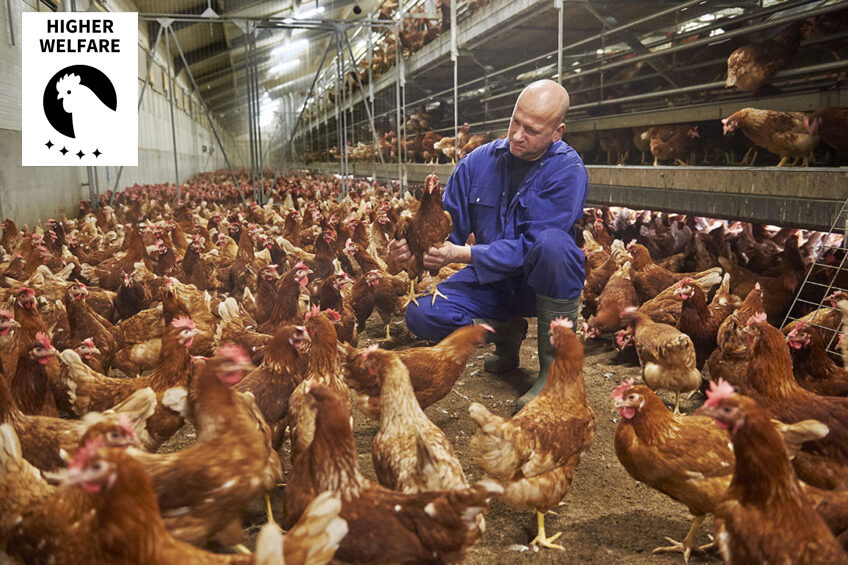Challenges of an aviary housing system

Conventional cages for egg production have been banned in the European Union since January 2012. Thus, alternative systems such aviary housing systems have become fairly common. Although an aviary housing system has many advantages, putting laying hens in larger groups in a more complex environment presents new management, health and welfare challenges.
In an aviary housing system laying hens have more social interaction, which can increase the risk of infectious diseases spreading to the whole flock. Infectious diseases, in turn, activate the immune system which can lead to the development of damaging behaviour, impaired body condition and welfare issues. This article discusses the health and behavioural challenges related to aviary housing systems.
Health-related challenges
Dust and ammonia levels are often high in an aviary housing system. Dust particles carry bacteria, fungi, bacterial toxins and mycotoxins. Exposure to respirable dust and ammonia for a long period of time can lead to a hypersensitivity reaction, the formation of lesions in the respiratory tract, a greater predisposition to respiratory disease and secondary infections, as well as keratoconjunctivitis in laying hens.
High ammonia levels are further associated with increased levels of stress hormones and destructive behaviour, such as feather pecking. It is important to consider that heat, humidity, crowding, social stress, and lack of general stimulation will enhance the stress level, along with the risk of infection and clinical disease of the reproductive tract.
The incidence of salpingitis and peritonitis caused by pecking around the cloaca region is significantly higher in an aviary housing system when birds are not beak trimmed. Moreover, an aviary housing system is more demanding in terms of ensuring thorough cleaning and disinfection, which then increases the risk of parasite infestation, such as red mites and coccidiosis. Another health issue related to aviary housing systems is keel bone damage, specifically bone fractures and bone deviations in commercially raised laying hens.
Immune system linked to damaging behaviour
The immune system and immune cells are involved in brain development and thus influence laying hen behaviour. Cytokines and chemokines can target the neurocircuits involved in regulating mood, motor activity, motivation and anxiety and alter behaviours such as feed and water intake, activity levels, exploration and social interaction. Cytokines affect behaviour through their impact on the synthesis, re-uptake and release of neurotransmitters, such as serotonin, dopamine and glutamate.
Studies have shown a genetic association between the immune system and feather damage as an indicator for feather pecking. Feather pecking is also linked to coping styles, increased stress sensitivity, motor activity, motivation and fearfulness; and it is cytokines that target the brain areas involved in the regulation of these behaviours.
In addition, there are genetic associations between severe feather pecking and specific antibody responses. For example, severely feather-pecked birds show an increased antibody response to infectious bursal disease virus vaccination. Exposure to immune challenges at a young age also stimulates feather-damaging behaviour later in life. Systemic bacterial infections, such as Erysipelas, are linked to poor feather coverage and skin damage, while parasitic infestation in aviary housing systems impacts the development of damaging behaviour in laying hens, thereby reducing health, performance production and plumage coverage in laying flocks.
Damaging behaviour
In an aviary housing system, feather pecking is a critical issue which degrades feather cover in those affected, interferes with body heat regulation, makes laying hens more susceptible to the cold, and increases skin damage caused by abrasion from the environment and other flock members. Skin damage further triggers cannibalism, lowers body weight and results in increased mortality of feather-pecked birds.
Feather damage and removal are major stressors for birds and affect the structural cohesiveness of the feathers, decreasing the aerodynamic capacity of the wings, making them less efficient in maintaining balance. Something which is challenging when using perches and navigating the aviary housing system. During feather removal, birds show crouching immobility with no outward sign of pain, a learned helplessness experienced by birds in traumatic events. However, during initial feather removal, birds become agitated, with wing flapping, vocalisation, an increased heart rate, raised blood pressure and EEG arousal as clear signs of experienced pain.
Tackling issues
To prevent keel bone damage, soft perches made from compressible materials can be used to absorb the kinetic energy released during collisions and to enhance the spread of pressure on the keel bone during perching. Genetic selection for more resilient bones and modified feeding also appear as promising methods for reducing keel bone damage in commercial laying hen systems.
Ways to reduce the risk of injurious pecking include avoiding rapid changes in feed provided for the hens, sudden unexpected noises and equipment malfunctions, alteration in light intensity and lighting patterns, and underweight or uneven flocks with wide variations in bird weights. Select quality pullets robust enough to cope with changes in the environment and management that have been reared in housing conditions closely mirroring those that the bird will encounter on the laying farm.
Management is key
Laying hen health and damaging behaviours are closely related in modern husbandry systems. Aviary housing systems offer birds more freedom to express their natural instincts and increase the social interaction between birds. Besides all the positive impacts of aviary housing systems, if rearing and management conditions are less than optimum, this can result in destructive behaviour, infectious diseases, impaired body condition and health and welfare issues affecting the whole flock. This makes it necessary to monitor both the behaviour and health of laying hens and intervene immediately to preserve the health and welfare of the birds, as well as maintain producers’ income and profitability.












